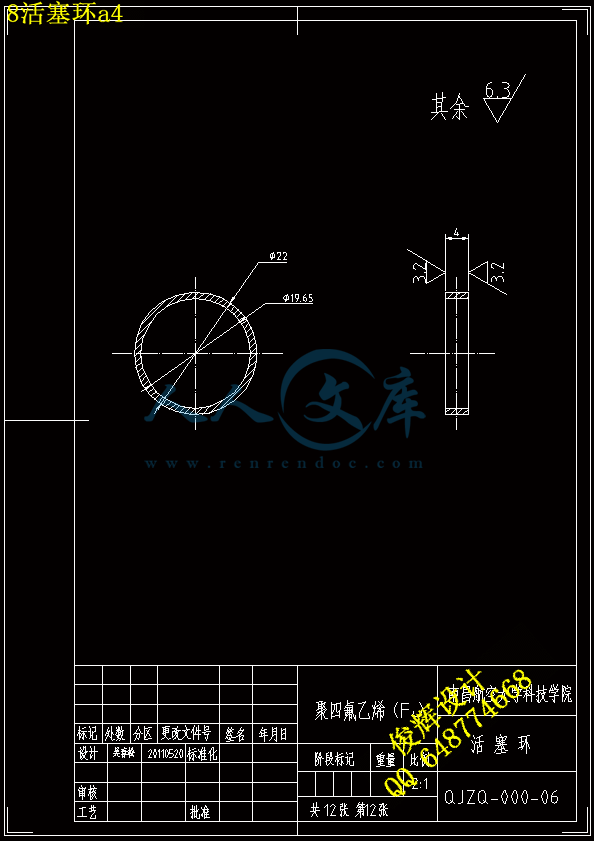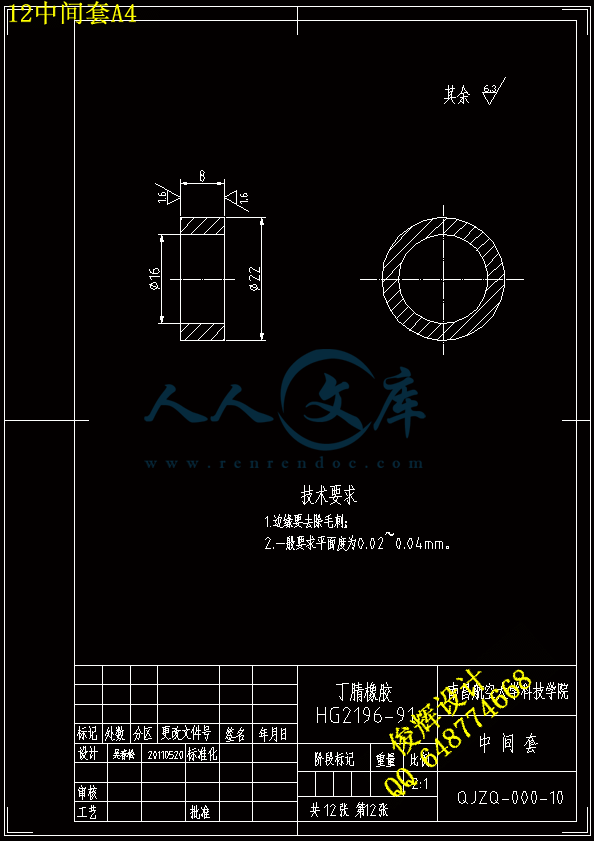目 录
1 绪论………………………………………………………………………………(1)
2 总体方案设计
2.1 研究内容及实验方案…………………………………………………………(3)
2.2 工作原理………………………………………………………………………(3)
3 摩托车减震器的功能和结构形式
3.1 减震器的功能…………………………………………………………………(5)
3.2 摩托车前减震器的结构形式…………………………………………………(5)
3.2.1 弹簧空气式…………………………………………………………………(5)
3.2.2 单筒伸缩式…………………………………………………………………(5)
3.2.3 双筒伸缩式…………………………………………………………………(6)
3.2.4 油—汽伸缩式………………………………………………………………(6)
3.2.5 防下沉伸缩式前减震器……………………………………………………(7)
4 摩托车后减震器的主要特性
4.1 摩托车减震器的弹簧特性……………………………………………………(8)
4.1.1 摩托车悬挂装置的挠度……………………………………………………(8)
4.1.2 摩托车悬挂装置的理想弹簧特性…………………………………………(9)
4.2 摩托车减震弹簧的材料及工艺………………………………………………(10)
4.2.1 弹簧材料的种类……………………………………………………………(10)
4.2.2弹簧制造工艺………………………………………………………………(11)
4.3 摩托车减震器的阻尼特性……………………………………………………(11)
4.3.1 阻力——速度特性…………………………………………………………(11)
4.3.2 阻力——位移特性…………………………………………………………(13)
4.4 摩托车减震器的阻尼力………………………………………………………(14)
4.4.1 复原行程阻尼力计算………………………………………………………(14)
4.4.2 压缩行程阻尼力计算………………………………………………………(16)
4.4.3 减震器额定阻力……………………………………………………………(17)
4.4.4 示功图………………………………………………………………………(17)
5 摩托车后减震器的结构设计
5.1 减震器的主要零件结构参数…………………………………………………(19)
5.1.1 工作缸径的确定……………………………………………………………(19)
5.1.2 贮油筒径的确定……………………………………………………………(19)
5.1.3 减震器基长的确定…………………………………………………………(20)
5.1.4 工作行程……………………………………………………………………(20)
5.2 摩托车后减震器主要零件的结构设计………………………………………(21)
5.2.1 弹簧的结构尺寸设计和计算………………………………………………(21)
5.2.2 减震弹簧按实际工作状态绘图的优点……………………………………(24)
5.2.3 减震器减震杆杆的设计……………………………………………………(24)
5.2.4 活塞环设计计算……………………………………………………………(26)
5.2.5 贮 油 筒……………………………………………………………………(29)
5.2.6 导向套(衬套)……………………………………………………………(30)
5.2.7 油封…………………………………………………………………………(31)
6 摩托车减震器主要零部件的组装工艺
6.1 装配工艺原则…………………………………………………………………(34)
6.2 装配工艺流程…………………………………………………………………(34)
6.2.1 活塞、活塞杆的装配………………………………………………………(34)
6.2.2 前减震器总成装配…………………………………………………………(35)
7 摩托车后减震器的检验与质量评定
7.1 出厂检验………………………………………………………………………(36)
7.2 减震器型式检验………………………………………………………………(36)
7.3 减震器质量等级评定方法……………………………………………………(37)
8 总结………………………………………………………………………………(38)
参考文献……………………………………………………………………………(39)
致 谢……………………………………………………………………………(40)
摘要:减震器又称缓冲器,是安装在摩托车悬挂装置上的一个重要零件。摩托车悬挂装置不仅决定了乘坐的舒适度,而且还是决定其运动性能的重要部件。而减震器的功能就是缓和由于路面不平引起的冲击,衰减摩托车的振动;提高乘坐舒适性,保护货载;减低车体各部分的运应力,增加零件的寿命;加强轮胎的附着性,有助于摩托车的操纵性、稳定性。
本文所设计的摩托车前减震器采用液力式减震方式,其工作行程为50 mm。通过弹簧减震为主。设计时减震弹簧采用组合式弹簧,由两段节距不同的等节距圆柱弹簧组成。在通常振动范围内,弹簧柔软,当车辆受到冲击时,弹簧变硬,有足够的能力吸收这种冲击能量。减震器的机能是利用流体通过减震杆上的孔、隙产生的粘性阻力。和固体摩托减震相比,利用液体紊流阻力的减震器,在一定阻尼力和吸收能量的条件下,质量小,尺寸小,并在相当的范围内具有能任意规定阻尼力对工作速度的关系等优点。
在设计过程中对前减震器的工作原理进行了说明,并确定了工作部分主要零件的相关参数,在已知条件的前提下分别对减震弹簧直径和自由高度,阻尼孔的数量和直径等进行设计计算。
关键词:前减震器 弹簧 阻尼 设计
The design of motorcycle before
Abstract : Dampers also known as buffer , is the installation of the hoisting device an important component . Motorcycle hoisting device will not only decide the ride comfort, but also to determine their performance movement of important parts . And the function of a shock absorber is easing due to the road surface uneven, the effect of vibration attenuation motorcycle; improveing ride comfort, Protection of cargo; reduceing the stress of the body operation, increaseing the life expectancy of components; strengthen tire adhesion. helping manipulation and stability of Motorcycle.
In this paper , motorcycle before shock absorber and the overall program analysis and design is the main content. Useing hydraulic shock absorber, its itinerary to 50 mm . Mainly through the spring damping, supplemented dampers. Damping spring design using modular spring,the combination of spring two such different pitchs pitch cylindrical spring,. In the normal range of vibration, soft spring, when the vehicles to be shocked, springs stiffen and have sufficient capacity to absorb the impact energy . Damper function use the fluid through the Absorption of shock pole on the hole, the gap viscous resistance . And compared to solid motorized damping, the use of liquid turbulent resistance dampers, to a certain damping force and absorb energy conditions, Quality small, size small, and the lack of scale with arbitrary requirements damping force on the relationship between the pace of work and so on.
In the process of designing,there are a note On the before shock absorber working principle , and to identify the major components of the work of the relevant parameters, Respectively damping springs, which includes determination and free height of the damping spring, Damping hole quantity and determination for the design and rehabilitation of resistance
Keywords :before the shock absorber damping spring damper design
1 绪论
世界上第一个有记载、比较简单的减震器是1897年由两个姓吉明的人发明的。他们把橡胶块与叶片弹簧的端部相连,当悬架被完全压缩时,橡胶减震块就碰到连接在汽车大梁上的一个螺栓,产生止动。这种减震器在很多现代汽车悬架上仍有使用,但其减震效果很小。
机动脚踏两用车实际上是内燃机技术与自行车技术相结合的产物,它开辟了摩托车的实用时代。随着摩托车的快速和适应野外行驶的需要,必须提高车辆对路面的缓冲能力。早在1899年,贝劳摩托车上开始用了弹性后悬挂装置,后来比利时型摩托车采用了前轮弹性悬挂,以及英吉安C摩托车采用的前、后轮弹性悬挂均可算作早期摩托车悬挂装置的杰出代表。
特别是二轮摩托车在操作性、稳定性、舒适性方面,与悬挂装置有着重要的关系。1990年就开始在前轮采用金属弹簧张力的双向、平行连接装置,30年代便发明了利用管内粘性机油的液压减震器。1995年后前轮悬挂装置就采用了伸缩管式和底部杠杆式两类前叉。在伸缩筒式前叉、望远镜式的二个筒内由于有螺旋弹簧和油缸,加工精度要求高,生产效率很低,阻碍了发展和应用。1960年二轮摩托车的大批量生产,底部杠杆式前叉处于全盛时期,该系统具有结构简单、价格低廉等优点。后来伸缩筒式前叉又重新上市,用于当时盛行一时的两轮赛车上,伸缩筒式前叉优秀的行驶性能方被充分证明。因此,大批量生产的摩托车也竞相采用伸缩筒式前叉,而且由于加工技术的提高,伸缩筒式生产精度也得到了保证。所以,至今为止,各种型式的两轮摩托车都采用伸缩筒式前叉。
1910年开始对后轮悬挂装置的要求也迫切了,由于全链条传递驱动力,后轮必须采用长距离的固定方式。所以车体的缓冲仅只在坐垫下面安装有一金属弹簧。1950年才开始有正式的后悬挂装置。最初称为滑栓式,并尝试采用摇臂式。50年代后半期才确立了摇臂式后悬挂装置,即是现代两轮摩托车的后悬挂装置的基础。
同样,为了提高行驶稳定性、乘坐舒适性,后轮行程逐年增大,减震器组件行程在结构上受到了限制。因此前倾后减震器、后减震器组件安装位置前移等,用以增大杠杆比的方法增大后抡幸臣。进入70年代又开发了装有单减震器的单减震系统,特别是1973年开始用与越野车之后,公路赛车,大型运动车均很快地采用了这种单减震器后悬挂系统。
两轮摩托车,其发动机排量从50的家用车到1500的大型旅游车。对悬挂装置,根据不同排量、不同用途的车辆的要求,其设计的方法各有不同,但又存在有共同之处,即最近的悬挂装置将行驶稳定性、操终性、舒适性都放在主要位置上。
大部分两轮车还是采用液压式伸缩式前叉,除了要求完全吸收较大的冲击,提高结构刚度外,最后采用经四氟乙烯(teflon)处理的金属套筒用作滑动表面,大大的减小了伸缩筒运动时产生的摩擦。
两轮车增大车轮行程就具有良好的舒适性,最近前叉行程增大为140~180mm,越野车可达300mm左右,且具有降低弹簧刚度、阻尼力的倾向,向提高稳定性的方向发展。当然在不断增大车轮运动行程,两轮车在一人或二人乘坐的不同载荷条件下,车体下沉量是不同的。特别是制动时由于重心前移,车体姿势变化更大。采用空气调节式的油气悬挂装置或抗“点头”装置的悬挂装置,可以有效地防止紧急制动时的车体前倾变化。
自从20世纪60年代开始,几乎每年都有几十项减震器专利出现,表1是《汽车文摘》摘录的汽车悬架减震器专利技术的统计,其中在美国申请的专利技术尤为多,且专利申请人大多是日本的公司和个人。国内外减震器产品在许多方面存在着较大的差距:(1)产品的结构与性能方面(减震器的可拆性与速度特性间的差距);(2)制造技术与工艺设备方面(原材料、减震油、橡胶制品、连杆制造工艺、冲压工艺、粉末冶金制造工艺、贮油筒制造工艺等方面的差距);(3)测试手段方面;(4)总成装配方面,此外,由于轿车减震器是作为一个不可拆元件整体出厂销售的,一旦其中某个小零件发生失效,整个减震器也就报废了,因而减震器技术的发展和研究应该成为我国汽车行业发展和水平提高的一个重要课题。
我国自1957年7月洪都机械厂成功地仿制M72型边三轮摩托车,揭开了我
国生产摩托车的历史以来,到1978年摩托车生产量为1.2万辆。改革开放以来,
我国摩托车生产量得到了飞速增长,品种不断增多。目前在我国已形成了自己摩
托车工业生产体系,到1995年的生产量超过700万辆,已成为世界上第一摩托车生产国。与摩托车生产相适应的减震器产量已达1500万支,能生产9大系列50余种型号,基本满足了我国摩托车生产的发展需要,部分产品已达到了国际同类产品水平,为我国摩托车工业的技术水平提高和发展打下了基础。
2 总体方案设计
2.1研究内容及实验方案
研究内容:
(1)减震器整体方案分析与设计
(2) 摩托车减震器系统的弹簧特性
①摩托车悬挂装置的挠度
②摩托车悬挂装置的理想弹簧特性
③摩托车悬挂装特性置的实际弹簧
(3) 弹簧的材料及工艺
①弹簧材料的选用
②弹簧的制造工艺
(4) 减震器的速度特性及阻尼力
①节流阀的压力特性
②减震器的速度特性
③减震器阻尼力产生原理
实验方案:
前减震器有很多种,常见的有弹簧空气阻尼式前叉、弹簧液力阻尼式减震器、油—气伸缩式减震器等。
其中弹簧空气阻尼式前叉虽然结构简单、造价低,但是它是以活塞管之间的间隙为空气阻尼的双向用途减震器,所以起减震效果不及其他结构的理想。然而油—气伸缩式减震器的减震效果都很佳,甚至达到理想的减震效果,增加了舒适性和安全性。但其结构复杂,造价昂贵,大都用在大型或高级二轮车上,如雅马哈XJ750型、XJ750EⅡ,铃木GS750型赛车等。
而弹簧液力阻尼式减震器不但结构简单,造价低,而且减震效果好,所以我将采用弹簧液力阻尼式前减震器作为我的实验方案。













 川公网安备: 51019002004831号
川公网安备: 51019002004831号